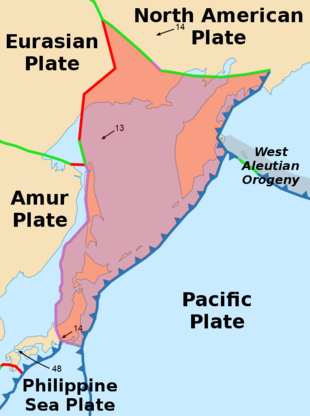Earth:Okhotsk Plate
| Okhotsk Plate | |
|---|---|
 | |
| Type | Minor |
| Movement1 | South-west |
| Speed1 | 13–14 mm/year |
| Features | Hokkaido, Kamchatka Peninsula, Kantō, Kuril Islands, Magadan Oblast, Sakhalin Island, Sea of Okhotsk, Tōhoku |
| 1Relative to the African Plate | |
The Okhotsk Plate is a minor tectonic plate covering the Kamchatka Peninsula, Magadan Oblast, and Sakhalin Island of Russia; Hokkaido, Kantō and Tōhoku regions of Japan; the Sea of Okhotsk, as well as the disputed Kuril Islands. It was formerly considered a part of the North American Plate, but recent studies from the 1990s onwards indicate that it is an independent plate, bounded on the north by the North American Plate.[1][2] The boundary is a left-lateral moving transform fault, the Ulakhan Fault originating from a triple junction in the Chersky Range.[3] On the east, the plate is bounded by the Pacific Plate at the Kuril–Kamchatka Trench and the Japan Trench, on the south by the Philippine Sea Plate at the Nankai Trough, on the west by the Eurasian Plate, and on the southwest by the Amurian Plate.[4]
Geology
The boundary between Okhotsk Plate and Amurian Plate might be responsible for many strong earthquakes that occurred in the Sea of Japan as well as in Sakhalin Island, such as the MW7.1 (MS7.5 according to other sources) earthquake of May 27, 1995 in northern Sakhalin.[5][6][7] The earthquake devastated the town of Neftegorsk, which was not rebuilt afterwards. Other notable intraplate earthquakes, such as the 1983 Sea of Japan earthquake and the 1993 Hokkaidō earthquake, have triggered tsunamis in the Sea of Japan.
The boundary between Okhotsk Plate and Pacific Plate is a subduction zone, where the Pacific Plate subducts beneath the Okhotsk Plate. Many strong megathrust earthquakes occurred here, some of them among the largest on world record, including the Kamchatka earthquakes of 1737 (estimated M9.0~9.3) and 1952 (M9.0). Such strong megathrust earthquakes can also occur near the Kuril Islands, as the M8.3 earthquake of November 15, 2006,[8][9] Hokkaido, as the M8.3 earthquake of September 26, 2003[10][11] and the M9.0 2011 Tōhoku earthquake off the coast of Honshu.[12]
GPS measurements and other studies show that the Okhotsk Plate is slowly rotating in a clockwise direction. Models indicate that it rotates 0.2 deg/Myr about a pole located north of Sakhalin.[2]
References
- ↑ Seno, Tetsuzo; Sakurai, Taro; Stein, Seth (1996). "Can the Okhotsk Plate be discriminated from the North American plate?". Journal of Geophysical Research: Solid Earth 101 (B5): 11305–11315. doi:10.1029/96JB00532. Bibcode: 1996JGR...10111305S.
- ↑ Jump up to: 2.0 2.1 Apel, E. V.; Bürgmann, R.; Steblov, G.; Vasilenko, N.; King, R.; Prytkov, A. (2006). "Independent active microplate tectonics of northeast Asia from GPS velocities and block modeling". Geophysical Research Letters 33 (11): L11303. doi:10.1029/2006GL026077. Bibcode: 2006GeoRL..3311303A.
- ↑ Mackey, Kevin; Lindauer, Susanne; Sedov, Boris; Hindle, David (2019-04-25). "The Ulakhan fault surface rupture and the seismicity of the Okhotsk–North America plate boundary". Solid Earth 10 (2): 561–580. doi:10.5194/se-10-561-2019. ISSN 1869-9510. Bibcode: 2019SolE...10..561H.
- ↑ Hindle, D.; Fujita, K.; Mackey, K. (2009). "Deformation of the Northwestern Okhotsk Plate: How is it happening?". Stephan Mueller Special Publication Series 4: 147–156. doi:10.5194/smsps-4-147-2009. Bibcode: 2009SMSPS...4..147H. https://smsps.copernicus.org/articles/4/147/2009/smsps-4-147-2009.pdf.
- ↑ Tamura, Makoto (2002). "The ShalIow Seismicity in the Southern Part of Sakhalin". Geophysical Bulletin of Hokkaido University 65: 127–142. http://eprints.lib.hokudai.ac.jp/dspace/bitstream/2115/14308/1/65_p127-142.pdf.
- ↑ "Earthquake Information for 1995". USGS. https://earthquake.usgs.gov/earthquakes/eqarchives/year/1995/.
- ↑ Arefiev, S. S. (2006). "Deep structure and tomographic imaging of strong earthquake source zones". Izvestiya, Physics of the Solid Earth 42 (10): 850–863. doi:10.1134/S1069351306100090. Bibcode: 2006IzPSE..42..850A.
- ↑ Matsumoto, Hiroyuki; Kawaguchi, Katsuyoshi; Asakawa, Kenichi (2007). "Offshore Tsunami Observation by the Kuril Islands Earthquake of 15 November 2006". 2007 Symposium on Underwater Technology and Workshop on Scientific Use of Submarine Cables and Related Technologies. Ieeexplore.ieee.org. pp. 482–487. doi:10.1109/UT.2007.370767. ISBN 978-1-4244-1207-5.
- ↑ "Magnitude 8.3 – KURIL ISLANDS". Earthquake.usgs.gov. https://earthquake.usgs.gov/eqcenter/eqinthenews/2006/usvcam/.
- ↑ Watanabe, Tomoki (2006). "Seismological monitoring on the 2003 Tokachi-oki earthquake, derived from off Kushiro permanent cabled OBSs and land-based observations". Tectonophysics 426 (1–2): 107–118. doi:10.1016/j.tecto.2006.02.016. Bibcode: 2006Tectp.426..107W.
- ↑ "Magnitude 8.3 – HOKKAIDO, JAPAN REGION". Earthquake.usgs.gov. https://earthquake.usgs.gov/eqcenter/eqinthenews/2003/uszdap/.
- ↑ Zhao, Dapeng; Liu, Xin (2018-06-01). "Upper and lower plate controls on the great 2011 Tohoku-oki earthquake". Science Advances 4 (6): eaat4396. doi:10.1126/sciadv.aat4396. ISSN 2375-2548. PMID 29938226. Bibcode: 2018SciA....4.4396L.
External links
- Okhotsk Plate Modeling
- Joint US-Russia Workshop on the Plate Tectonic Evolution of Northeast Russia, Dec. 2004
 |


